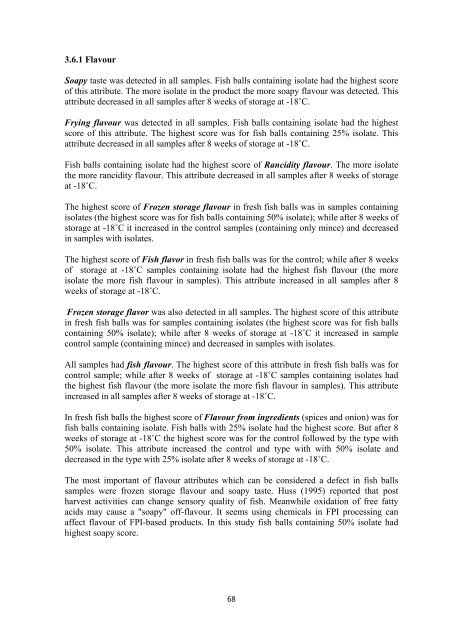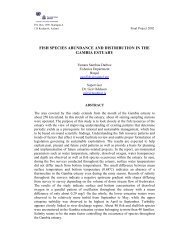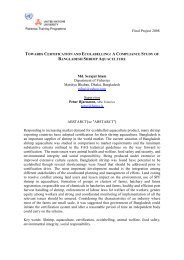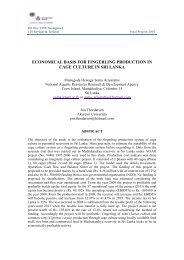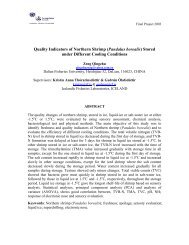Evaluation and Utilisation of Fish Protein Isolate Products
Evaluation and Utilisation of Fish Protein Isolate Products
Evaluation and Utilisation of Fish Protein Isolate Products
- No tags were found...
You also want an ePaper? Increase the reach of your titles
YUMPU automatically turns print PDFs into web optimized ePapers that Google loves.
3.6.1 FlavourSoapy taste was detected in all samples. <strong>Fish</strong> balls containing isolate had the highest score<strong>of</strong> this attribute. The more isolate in the product the more soapy flavour was detected. Thisattribute decreased in all samples after 8 weeks <strong>of</strong> storage at -18˚C.Frying flavour was detected in all samples. <strong>Fish</strong> balls containing isolate had the highestscore <strong>of</strong> this attribute. The highest score was for fish balls containing 25% isolate. Thisattribute decreased in all samples after 8 weeks <strong>of</strong> storage at -18˚C.<strong>Fish</strong> balls containing isolate had the highest score <strong>of</strong> Rancidity flavour. The more isolatethe more rancidity flavour. This attribute decreased in all samples after 8 weeks <strong>of</strong> storageat -18˚C.The highest score <strong>of</strong> Frozen storage flavour in fresh fish balls was in samples containingisolates (the highest score was for fish balls containing 50% isolate); while after 8 weeks <strong>of</strong>storage at -18˚C it increased in the control samples (containing only mince) <strong>and</strong> decreasedin samples with isolates.The highest score <strong>of</strong> <strong>Fish</strong> flavor in fresh fish balls was for the control; while after 8 weeks<strong>of</strong> storage at -18˚C samples containing isolate had the highest fish flavour (the moreisolate the more fish flavour in samples). This attribute increased in all samples after 8weeks <strong>of</strong> storage at -18˚C.Frozen storage flavor was also detected in all samples. The highest score <strong>of</strong> this attributein fresh fish balls was for samples containing isolates (the highest score was for fish ballscontaining 50% isolate); while after 8 weeks <strong>of</strong> storage at -18˚C it increased in samplecontrol sample (containing mince) <strong>and</strong> decreased in samples with isolates.All samples had fish flavour. The highest score <strong>of</strong> this attribute in fresh fish balls was forcontrol sample; while after 8 weeks <strong>of</strong> storage at -18˚C samples containing isolates hadthe highest fish flavour (the more isolate the more fish flavour in samples). This attributeincreased in all samples after 8 weeks <strong>of</strong> storage at -18˚C.In fresh fish balls the highest score <strong>of</strong> Flavour from ingredients (spices <strong>and</strong> onion) was forfish balls containing isolate. <strong>Fish</strong> balls with 25% isolate had the highest score. But after 8weeks <strong>of</strong> storage at -18˚C the highest score was for the control followed by the type with50% isolate. This attribute increased the control <strong>and</strong> type with with 50% isolate <strong>and</strong>decreased in the type with 25% isolate after 8 weeks <strong>of</strong> storage at -18˚C.The most important <strong>of</strong> flavour attributes which can be considered a defect in fish ballssamples were frozen storage flavour <strong>and</strong> soapy taste. Huss (1995) reported that postharvest activities can change sensory quality <strong>of</strong> fish. Meanwhile oxidation <strong>of</strong> free fattyacids may cause a "soapy" <strong>of</strong>f-flavour. It seems using chemicals in FPI processing canaffect flavour <strong>of</strong> FPI-based products. In this study fish balls containing 50% isolate hadhighest soapy score.68


